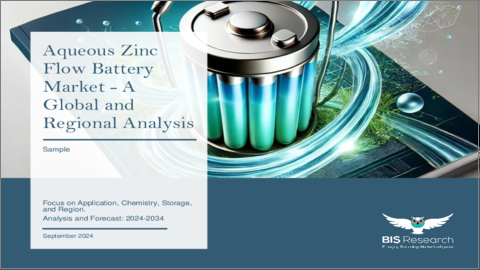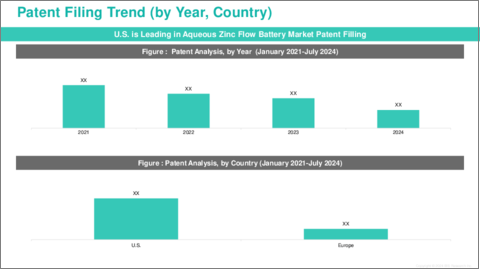|
|
市場調査レポート
商品コード
1560927
水系亜鉛フロー電池市場 - 世界および地域別分析:用途別、化学別、ストレージ別、地域別 - 分析と予測(2024年~2034年)Aqueous Zinc Flow Battery Market - A Global and Regional Analysis: Focus on Application, Chemistry, Storage, and Region - Analysis and Forecast, 2024-2034 |
||||||
カスタマイズ可能
|
|||||||
| 水系亜鉛フロー電池市場 - 世界および地域別分析:用途別、化学別、ストレージ別、地域別 - 分析と予測(2024年~2034年) |
|
出版日: 2024年09月25日
発行: BIS Research
ページ情報: 英文 110 Pages
納期: 1~5営業日
|
全表示
- 概要
- 目次
水系亜鉛フロー電池市場は、様々な市場促進要因に後押しされ、大きな成長が見込まれています。
楽観的シナリオでは、2024年の市場規模は2億5,960万米ドルになるとみられ、23.60%のCAGRで拡大し、2034年には21億5,980万米ドルに達すると予測されています。
水系亜鉛フロー電池市場は、スケーラブルで持続可能なエネルギー貯蔵ソリューションに対する緊急のニーズによって推進されています。太陽光や風力などの再生可能エネルギーへの世界の移行が加速する中、これらのエネルギー源の断続性が大きな課題となっています。水系亜鉛フロー電池は、大量のエネルギーを貯蔵し、必要なときに放出する能力により、堅牢なソリューションを提供します。無害で、豊富で、リサイクル可能な材料を使用する亜鉛ベースのシステム固有の安全性と環境上の利点は、大規模なエネルギー貯蔵プロジェクトにとって非常に魅力的です。これは、産業界や政府が二酸化炭素排出量を削減し、厳しい環境規制を満たすことを目指しているため、特に重要です。
| 主要市場統計 | |
|---|---|
| 予測期間 | 2024年~2034年 |
| 2024年の評価 | 2億5,960万米ドル |
| 2034年の予測 | 21億5,980万米ドル |
| CAGR | 23.6% |
水系亜鉛フロー電池の技術と費用対効果の進歩も重要な促進要因です。最近の技術革新により、これらの電池のエネルギー密度、効率、寿命が改善され、従来のリチウムイオン電池との競合が激しくなっています。ジンクフロー電池システムのモジュール性と拡張性により、住宅用エネルギー貯蔵からグリッド規模の設備まで、幅広い用途に対応することができます。さらに、亜鉛の価格が比較的安く、製造工程が単純であることも、この電池の経済性を高めています。その結果、水系亜鉛フロー電池の性能をさらに向上させ、コストを削減するための研究開発への投資が増加しており、さまざまな分野での採用が進んでいます。
アジア太平洋は、産業の急速な成長、再生可能エネルギーへの大規模な投資、持続可能な技術に対する政府の強力な支援により、水系亜鉛フロー電池の最大市場となっています。中国、日本、韓国のような国々は、エネルギー需要が大きい主要産業拠点であり、信頼性が高く効率的なエネルギー貯蔵ソリューションの必要性を後押ししています。水系亜鉛フロー電池の拡張性と安全性は、この地域で拡大する太陽光発電と風力発電のインフラによって生成される断続的なエネルギーを管理するのに理想的です。これは、エネルギー安全保障を強化し、化石燃料への依存を減らすというこの地域の目標に合致しています。
当レポートでは、世界の水系亜鉛フロー電池市場について調査し、市場の概要とともに、用途別、化学別、ストレージ別、地域別の動向、および市場に参入する企業のプロファイルなどを提供しています。
目次
エグゼクティブサマリー
第1章 市場:業界の展望
- 動向:現在および将来の影響評価
- サプライチェーンの概要
- R&Dレビュー
- 規制状況
- ステークホルダー分析
- 主要な世界的イベントの影響分析
- 市場力学の概要
第2章 水性亜鉛フロー電池市場(用途別)
- 用途のセグメンテーション
- 用途の概要
- 水性亜鉛フロー電池市場(用途別)
第3章 水性亜鉛フロー電池市場(製品別)
- 製品セグメンテーション
- 製品概要
- 水性亜鉛フロー電池市場(化学別)
- 水性亜鉛フロー電池市場(ストレージ別)
第4章 水性亜鉛フロー電池市場(地域別)
- 水性亜鉛フロー電池市場(地域別)
- 北米
- 欧州
- アジア太平洋
- その他の地域
第5章 企業プロファイル
- 今後の見通し
- 地理的評価
- CellCube
- Sumitomo Electric Industries
- Invinity Energy Systems
- Lockheed Martin
- ESS Tech, Inc.
- Largo Inc
- Primus Power Solutions
- SCHMID Group
- VRB Energy
- REDFLOW Ltd
第6章 調査手法
Introduction to Aqueous Zinc Flow Battery Market
The aqueous zinc flow battery market is expected to have significant growth, propelled by various key factors and market drivers. In an optimistic scenario, the market is evaluated at a valuation of $259.6 million in 2024 and is projected to expand at a CAGR of 23.60% to reach $2,159.8 million by 2034.
The market for aqueous zinc flow batteries is being propelled by the urgent need for scalable and sustainable energy storage solutions. As the global transition towards renewable energy sources like solar and wind accelerates, the intermittency of these energy sources presents a significant challenge. Aqueous zinc flow batteries offer a robust solution due to their ability to store large amounts of energy and release it when needed, thereby stabilizing the grid and ensuring a reliable energy supply. The inherent safety and environmental benefits of zinc-based systems, which use non-toxic, abundant, and recyclable materials, make them highly attractive for large-scale energy storage projects. This is particularly important as industries and governments aim to reduce their carbon footprints and meet stringent environmental regulations.
| KEY MARKET STATISTICS | |
|---|---|
| Forecast Period | 2024 - 2034 |
| 2024 Evaluation | $259.6 Million |
| 2034 Forecast | $2,159.8 Million |
| CAGR | 23.6% |
Another key driving factor is the advancements in technology and cost-effectiveness of aqueous zinc flow batteries. Recent innovations have led to improvements in energy density, efficiency, and lifespan of these batteries, making them more competitive with traditional lithium-ion batteries. The modularity and scalability of zinc flow battery systems allow them to be tailored for a wide range of applications, from residential energy storage to grid-scale installations. Furthermore, the relatively low cost of zinc and the simpler manufacturing processes associated with these batteries contribute to their economic viability. As a result, there is increasing investment in research and development to further enhance the performance and reduce the costs of aqueous zinc flow batteries, thereby driving their adoption across various sectors.
The Asia-Pacific region is the largest market for aqueous zinc flow batteries due to its rapid industrial growth, extensive investment in renewable energy, and strong government support for sustainable technologies. Countries like China, Japan, and South Korea are major industrial hubs with significant energy demands, driving the need for reliable and efficient energy storage solutions. The scalability and safety of aqueous zinc flow batteries make them ideal for managing the intermittent energy generated by the region's expanding solar and wind power infrastructure. This aligns with the region's goals to enhance energy security and reduce dependence on fossil fuels.
Market Segmentation:
Segmentation 1: by Application
- Utilities
- Commercial and Industrial
- Automotive and Transportation
- EV Charging Stations
- Others
Segmentation 2: by Chemistry
- Zinc-Bromine Flow Batteries (Zn-Br)
- Zinc- Iron Flow Batteries (Zn-Fe)
- Zinc-Nickel Flow Batteries (Zn-Ni)
- Others
Segmentation 3: by Storage
- Large Scale
- Small Scale
Segmentation 4: by Region
- North America
- Europe
- Asia-Pacific
- Rest-of-the-World
How can this report add value to an organization?
Product/Innovation Strategy: The global aqueous zinc flow battery market has been extensively segmented based on various categories, such as application, chemistry, and storage. This can help readers get a clear overview of which segments account for the largest share and which ones are well-positioned to grow in the coming years.
Competitive Strategy: A detailed competitive benchmarking of the players operating in the global aqueous zinc flow battery market has been done to help the reader understand how players stack against each other, presenting a clear market landscape. Additionally, comprehensive competitive strategies such as partnerships, agreements, and collaborations will aid the reader in understanding the untapped revenue pockets in the market.
Key Market Players and Competition Synopsis
The companies that are profiled have been selected based on thorough secondary research, which includes analyzing company coverage, product portfolio, market penetration, and insights gathered from primary experts.
Some of the prominent companies in this market are:
- Invinity Energy Systems
- Sumitomo Electric Industries
- REDFLOW Ltd
- VRB Energy
- Primus Power Solutions
Key Questions Answered in this Report:
- What are the main factors driving the demand for aqueous zinc flow battery?
- What are the major patents filed by the companies active in the aqueous zinc flow battery market?
- Who are the key players in theaqueous zinc flow battery market, and what are their respective market shares?
- What partnerships or collaborations are prominent among stakeholders in the aqueous zinc flow battery market?
- What are the strategies adopted by the key companies to gain a competitive edge in the aqueous zinc flow battery market?
- What is the futuristic outlook for the aqueous zinc flow battery market in terms of growth potential?
- What is the current estimation of the aqueous zinc flow battery market and what growth trajectory is projected from 2024 to 2034?
- Which application, and product segment is expected to lead the market over the forecast period (2024-2034)?
- Which regions demonstrate the highest adoption rates for aqueous zinc flow battery market, and what factors contribute to their leadership?
Table of Contents
Executive Summary
Scope and Definition
Market/Product Definition
Key Questions Answered
Analysis and Forecast Note
1. Markets: Industry Outlook
- 1.1 Trends: Current and Future Impact Assessment
- 1.1.1 Enhanced Electrolyte Formulations and Additives.
- 1.1.2 Integration with Renewable Energy Systems
- 1.2 Supply Chain Overview
- 1.2.1 Value Chain Analysis
- 1.2.2 Pricing Forecast
- 1.3 R&D Review
- 1.3.1 Patent Filing Trend by Country, by Company
- 1.4 Regulatory Landscape
- 1.5 Stakeholder Analysis
- 1.5.1 Use Case
- 1.5.2 End User and Buying Criteria
- 1.6 Impact Analysis for Key Global Events
- 1.7 Market Dynamics Overview
- 1.7.1 Market Drivers
- 1.7.2 Market Restraints
- 1.7.3 Market Opportunities
2. Aqueous Zinc Flow Battery Market (by Application)
- 2.1 Application Segmentation
- 2.2 Application Summary
- 2.3 Aqueous Zinc Flow Battery Market by Application
- 2.3.1 Utilities
- 2.3.2 Commercial and Industrial
- 2.3.3 Automotive and Transportation
- 2.3.4 EV Charging Stations
- 2.3.5 Others (Medical Devices, Consumer Goods)
3. Aqueous Zinc Flow Battery Market (by Products)
- 3.1 Product Segmentation
- 3.2 Product Summary
- 3.3 Aqueous Zinc Flow Battery Market by Chemistry
- 3.3.1 Zinc-Bromine Flow Batteries (Zn-Br)
- 3.3.2 Zinc-Iron Flow Batteries (Zn-Fe)
- 3.3.3 Zinc-Nickel Flow Batteries (Zn-Ni)
- 3.3.4 Others
- 3.4 Aqueous Zinc Flow Battery Market by Storage
- 3.4.1 Large Scale
- 3.4.2 Small Scale
4. Aqueous Zinc Flow Battery Market (by Region)
- 4.1 Aqueous Zinc Flow Battery Market - by Region
- 4.2 North America
- 4.2.1 Regional Overview
- 4.2.2 Driving Factors for Market Growth
- 4.2.3 Factors Challenging the Market
- 4.2.4 Application
- 4.2.5 Product
- 4.2.6 U.S.
- 4.2.6.1 Market by Application
- 4.2.6.2 Market by Product
- 4.2.7 Canada
- 4.2.7.1 Market by Application
- 4.2.7.2 Market by Product
- 4.2.8 Mexico
- 4.2.8.1 Market by Application
- 4.2.8.2 Market by Product
- 4.3 Europe
- 4.3.1 Regional Overview
- 4.3.2 Driving Factors for Market Growth
- 4.3.3 Factors Challenging the Market
- 4.3.4 Application
- 4.3.5 Product
- 4.3.6 Germany
- 4.3.6.1 Market by Application
- 4.3.6.2 Market by Product
- 4.3.7 France
- 4.3.7.1 Market by Application
- 4.3.7.2 Market by Product
- 4.3.8 U.K.
- 4.3.8.1 Market by Application
- 4.3.8.2 Market by Product
- 4.3.9 Italy
- 4.3.9.1 Market by Application
- 4.3.9.2 Market by Product
- 4.3.10 Spain
- 4.3.10.1 Market by Application
- 4.3.10.2 Market by Product
- 4.3.11 Rest-of-Europe
- 4.3.11.1 Market by Application
- 4.3.11.2 Market by Product
- 4.4 Asia-Pacific
- 4.4.1 Regional Overview
- 4.4.2 Driving Factors for Market Growth
- 4.4.3 Factors Challenging the Market
- 4.4.4 Application
- 4.4.5 Product
- 4.4.6 China
- 4.4.6.1 Market by Application
- 4.4.6.2 Market by Product
- 4.4.7 Japan
- 4.4.7.1 Market by Application
- 4.4.7.2 Market by Product
- 4.4.8 India
- 4.4.8.1 Market by Application
- 4.4.8.2 Market by Product
- 4.4.9 South Korea
- 4.4.9.1 Market by Application
- 4.4.9.2 Market by Product
- 4.4.10 Rest-of-Asia-Pacific
- 4.4.10.1 Market by Application
- 4.4.10.2 Market by Product
- 4.5 Rest-of-the-World
- 4.5.1 Regional Overview
- 4.5.2 Driving Factors for Market Growth
- 4.5.3 Factors Challenging the Market
- 4.5.4 Application
- 4.5.5 Product
- 4.5.6 South America
- 4.5.6.1 Market by Application
- 4.5.6.2 Market by Product
- 4.5.7 Middle East and Africa
- 4.5.7.1 Market by Application
- 4.5.7.2 Market by Product
5. Companies Profiled
- 5.1 Next Frontiers
- 5.2 Geographic Assessment
- 5.2.1 CellCube
- 5.2.1.1 Overview
- 5.2.1.2 Top Products/Product Portfolio
- 5.2.1.3 Top Competitors
- 5.2.1.4 Target Customers
- 5.2.1.5 Key Personnel
- 5.2.1.6 Analyst View
- 5.2.1.7 Market Share
- 5.2.2 Sumitomo Electric Industries
- 5.2.2.1 Overview
- 5.2.2.2 Top Products/Product Portfolio
- 5.2.2.3 Top Competitors
- 5.2.2.4 Target Customers
- 5.2.2.5 Key Personnel
- 5.2.2.6 Analyst View
- 5.2.2.7 Market Share
- 5.2.3 Invinity Energy Systems
- 5.2.3.1 Overview
- 5.2.3.2 Top Products/Product Portfolio
- 5.2.3.3 Top Competitors
- 5.2.3.4 Target Customers
- 5.2.3.5 Key Personnel
- 5.2.3.6 Analyst View
- 5.2.3.7 Market Share
- 5.2.4 Lockheed Martin
- 5.2.4.1 Overview
- 5.2.4.2 Top Products/Product Portfolio
- 5.2.4.3 Top Competitors
- 5.2.4.4 Target Customers
- 5.2.4.5 Key Personnel
- 5.2.4.6 Analyst View
- 5.2.4.7 Market Share
- 5.2.5 ESS Tech, Inc.
- 5.2.5.1 Overview
- 5.2.5.2 Top Products/Product Portfolio
- 5.2.5.3 Top Competitors
- 5.2.5.4 Target Customers
- 5.2.5.5 Key Personnel
- 5.2.5.6 Analyst View
- 5.2.5.7 Market Share
- 5.2.6 Largo Inc
- 5.2.6.1 Overview
- 5.2.6.2 Top Products/Product Portfolio
- 5.2.6.3 Top Competitors
- 5.2.6.4 Target Customers
- 5.2.6.5 Key Personnel
- 5.2.6.6 Analyst View
- 5.2.6.7 Market Share
- 5.2.7 Primus Power Solutions
- 5.2.7.1 Overview
- 5.2.7.2 Top Products/Product Portfolio
- 5.2.7.3 Top Competitors
- 5.2.7.4 Target Customers
- 5.2.7.5 Key Personnel
- 5.2.7.6 Analyst View
- 5.2.7.7 Market Share
- 5.2.8 SCHMID Group
- 5.2.8.1 Overview
- 5.2.8.2 Top Products/Product Portfolio
- 5.2.8.3 Top Competitors
- 5.2.8.4 Target Customers
- 5.2.8.5 Key Personnel
- 5.2.8.6 Analyst View
- 5.2.8.7 Market Share
- 5.2.9 VRB Energy
- 5.2.9.1 Overview
- 5.2.9.2 Top Products/Product Portfolio
- 5.2.9.3 Top Competitors
- 5.2.9.4 Target Customers
- 5.2.9.5 Key Personnel
- 5.2.9.6 Analyst View
- 5.2.9.7 Market Share
- 5.2.10 REDFLOW Ltd
- 5.2.10.1 Overview
- 5.2.10.2 Top Products/Product Portfolio
- 5.2.10.3 Top Competitors
- 5.2.10.4 Target Customers
- 5.2.10.5 Key Personnel
- 5.2.10.6 Analyst View
- 5.2.10.7 Market Share
- 5.2.1 CellCube





